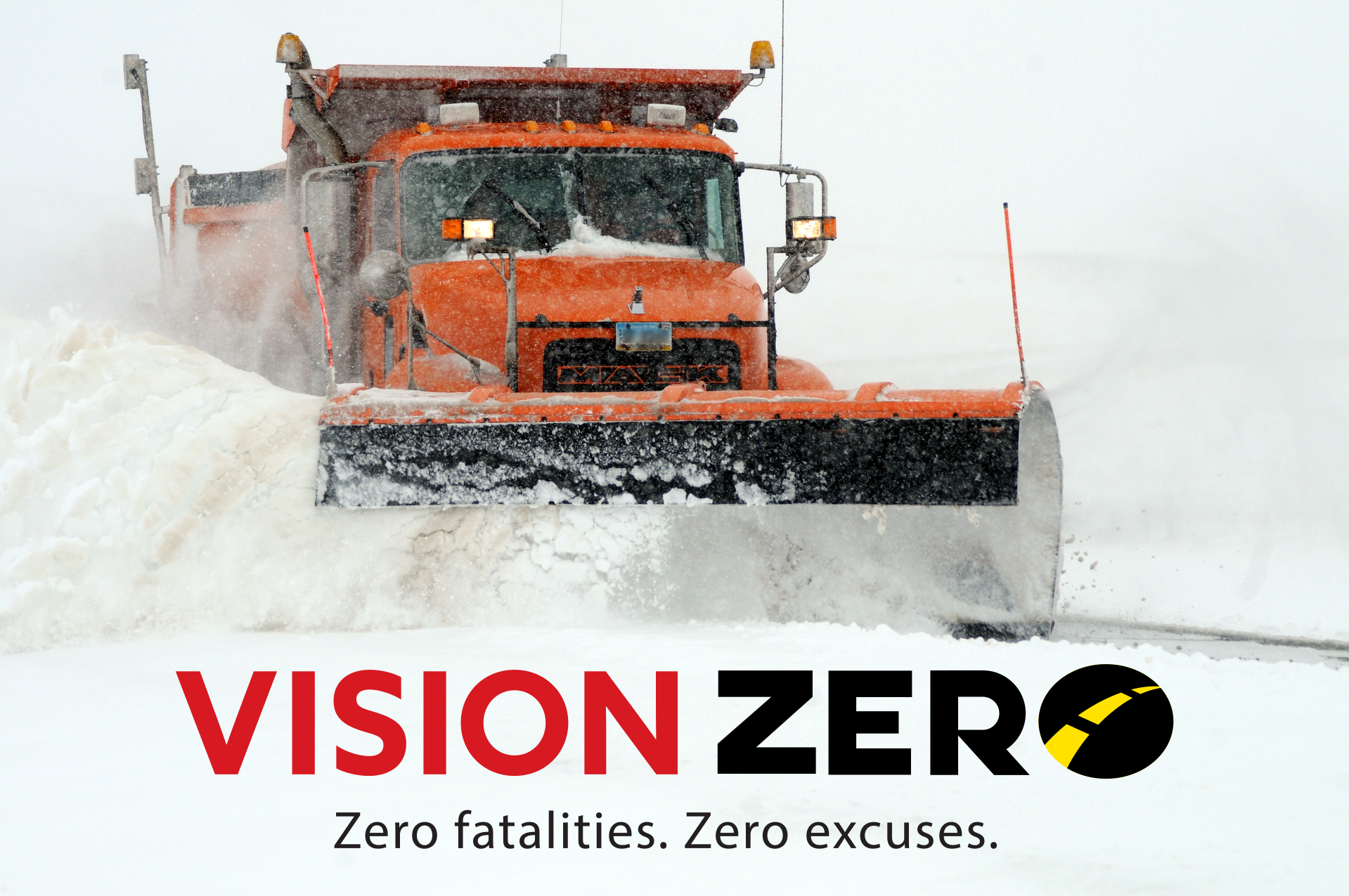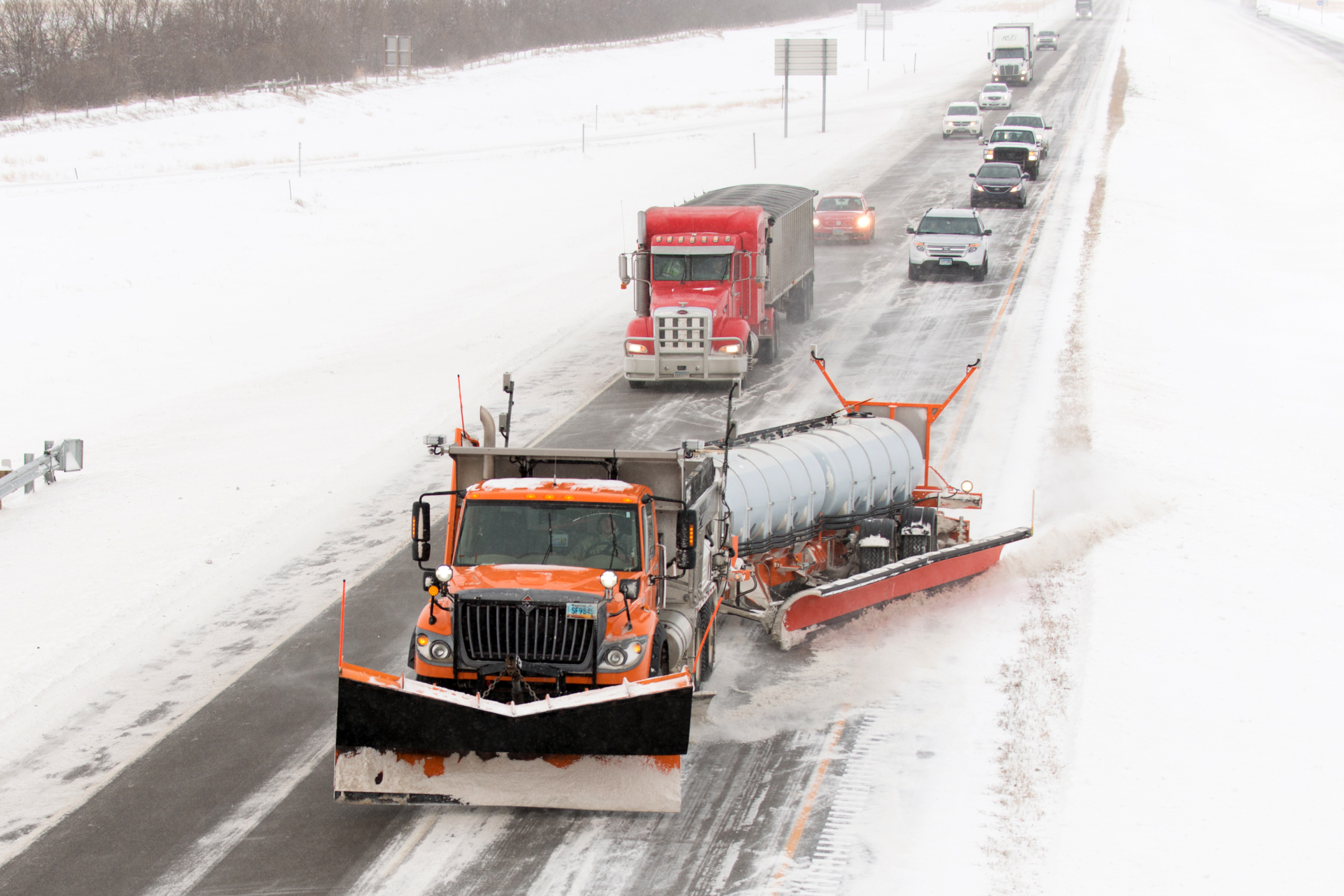The NDDOT snow and ice control operations are an important function for the department with nearly 7,500 roadway miles of highway to maintain. Winter in North Dakota presents many challenges and the NDDOT does its best to maintain and keep North Dakota’s highways safe for the traveling public.
The NDDOT works hard to keep travelers informed of road conditions. Road conditions are updated every day from 5 a.m. to 10 p.m. (CT). It’s important to remember that the conditions may vary from what is being reported. The road report is based upon the information available to the NDDOT at the time of preparation and is provided solely as a public service. Find the information you need here to plan ahead and know before you go so you can arrive at your destination safely.

Snow and Ice Control FAQ's
Can I pass a snowplow?
Yes, it is legal to pass a snowplow; however, it is highly discouraged. Motorists should also be aware of the “Move over Law.” If you approach a snowplow or other NDDOT maintenance vehicle with flashing lights that is stopped on the shoulder of a multi-lane road, you must move over to the lane that is not next to the snowplow or vehicle, if it is safe to change lanes. Snowplows do pull over when it is safe to do so to allow vehicles to pass. When passing a snowplow, it is important to remember they have wing blades that stick out 10 feet to the left or right which may not be visible because of blowing snow. If you absolutely must pass a snowplow, be sure to consider that the road in front of the snowplow may not have been plowed yet making it less safe for travel.
How do I find out about road conditions?
Road conditions and travel information are available by calling 511 or checking the North Dakota Travel Information Map. The information provided to both of these services is updated daily from 5 a.m. until 10 p.m. CT, including holidays. Road condition information is based on input from NDDOT snowplow crews who are out on the road and is provided solely as a public service. Conditions may vary from those reported because the conditions are not updated 24 hours a day.
What do I do if I get stranded on the highway during a winter storm?
Call 911. The dispatcher will ask you what highway you are on, where you are at, and if you need medical attention. The 911 dispatcher will assist in notifying towing services or medical services if needed. If you get stranded on the highway during a winter storm, it is important to stay with your vehicle and run the engine sparingly. Before you travel, you should always check the road conditions to see if it is safe, inform others of your intended route, carry a fully charged cell phone, and have a full tank of gas when you leave. Unless you are blocking the roadway, NDDOT snowplow trucks cannot pull you out if you are stuck, but they may be able to let you sit in the truck to warm up for a few minutes or assist in contacting emergency help. Snowplows need to keep plowing the roads to keep the roads open for the traveling public.
What equipment does NDDOT use for snow/ice removal?
NDDOT's main weapon for clearing snow and ice from the roads is the snowplow. In addition, the NDDOT uses snow blowers to blow large snow drifts off the road; bulldozers to push snow away from the road to reduce drifting and to make room for more snow; motor graders to bust through large drifts or cut compacted snow or ice off the road; and tow plows, a 26-foot trailer mounted plow that is pulled by a regular snow plow to clear an extra-wide path on the roadway.
What is the difference between a Travel Alert and No Travel Advisory?
Generally, road conditions are worse during a No Travel Advisory than a Travel Alert. It may still be OK to travel during a Travel Alert, but motorists should check road conditions before they go. A No Travel Advisory means conditions are hazardous and motorists should not travel. When a No Travel Advisory is issued by NDDOT, it only applies to state, U.S. and interstate highways. No Travel Advisories issued by county officials generally only apply to county roads.
What is the most common type of snowplow crash?
Most crashes with snowplows occur when a snowplow gets rear-ended by another vehicle. NDDOT urges motorists to slow down and double your normal following distance when sharing the road with a snowplow truck.
What should I do when I come up behind a snowplow?
Motorists are urged not to drive through “whiteouts” or “snow fog” caused by crosswinds or plowing of snow drifts. Snowplows pull over and stop when it is safe to do so to allow traffic to pass. The best practice for motorists is to be patient and wait until the snowplow pulls over to pass. Also, it is recommended to reduce your speed and double your normal following distance when following a snowplow.
Who determines what roads to close and when?
When a state, U.S., or interstate highway is blocked or is no longer considered safe for public travel, the North Dakota Highway Patrol may temporarily close the highway for the protection and safety of the public. Road closures are discussed and coordinated between the Highway Patrol and the NDDOT. It is against the law to drive past a road closure device, which is punishable by a fine up to $250. When a county or city road is blocked, the local law enforcement agency may temporarily close the roadway. Closures of county and city roadways are not coordinated with NDDOT.
Who is responsible for plowing city streets or county roads?
Local city crews or local county crews are typically responsible for plowing city and county roads. The NDDOT is only responsible for plowing state, U.S., and interstate highways. If one of these roads runs through your city, NDDOT may be responsible for plowing that highway only. City snow plow crews are responsible for the remaining roads within the city. If you have a question regarding a city street or county road, please contact your city or county.
Why does NDDOT spray water or liquids on the road on a clear day?
NDDOT is applying liquid ice melting material. The liquid melts snow and ice in temperatures well below zero degrees Fahrenheit and is generally a blend of water, salt, and a product that comes from sugar beets. Applying the liquids early helps melt snow and ice as they form and helps prevent snow or ice from bonding to the road. This method called anti-icing, or pre-treating, is a proactive approach to fighting snow and ice buildup. Effective anti-icing can reduce costs, reduce environmental impacts, improve service to the motorists, and enhance safety.
Why don't I ever seem to see a snowplow during a winter storm?
The NDDOT is responsible for snow removal on approximately 17,000 lane-miles of state, U.S., and interstate highways and does not maintain any city or county roadways. For comparison, the driving distance between Anchorage, Alaska and Miami, Florida is approximately 5,000 miles. With 350 trucks, the average time to complete a snow route is approximately two to three hours, but some can take up to four hours or more during a storm. Time is also needed to refuel the truck and load/unload deicing materials. Snowplows may temporarily stop plowing if storm conditions become so bad that it is unsafe for anybody to be on the road due to zero visibility.
Does the NDDOT use salt?
Yes. NDDOT uses either pure salt or a salt/sand mixture. Liquid ice-melting materials containing salt are also used. The material used depends on the storm conditions and the types of material available. Salt is the most cost effective way of lowering the freezing point of water which makes snow and ice melt, making it easier to remove from the roadway. Sand alone does not melt ice or snow. NDDOT uses sand mixed with salt to simply provide traction on the roadway. Granular materials such as salt and sand are normally pre-treated with salt brine (salt with water) to help the material stick to the road.
How do you remove compacted snow and ice from the road surface in extremely cold temperature?
NDDOT applies down pressure to ice scraping blades to help cut compacted snow and ice off the roadway and applies abrasive material (sand) onto the compacted snow and ice to help provide traction. Snow and ice removal from the road surface can become more challenging at extremely cold temperatures as the working temperature of deicers (salt) is less effective at extremely cold temperatures. One pound of salt can melt approximately 46.3 pounds of ice when the temperature is 30°. When the temperature drops to -6°, mark one pound of salt can only melt 3.2 pounds of ice. The colder the temperature, the higher the amount of salt is needed to melt snow and ice. Therefore, salt is less effective in extremely cold temperatures and NDDOT resorts to the practices of scraping and the application of abrasive material. When the temperature warms up deicers become more effective.
Snow Resources

